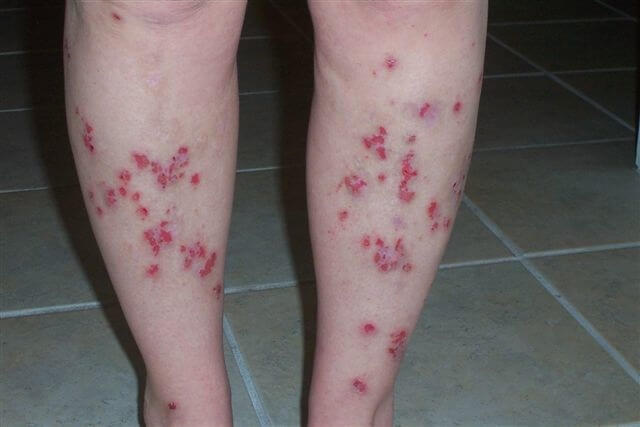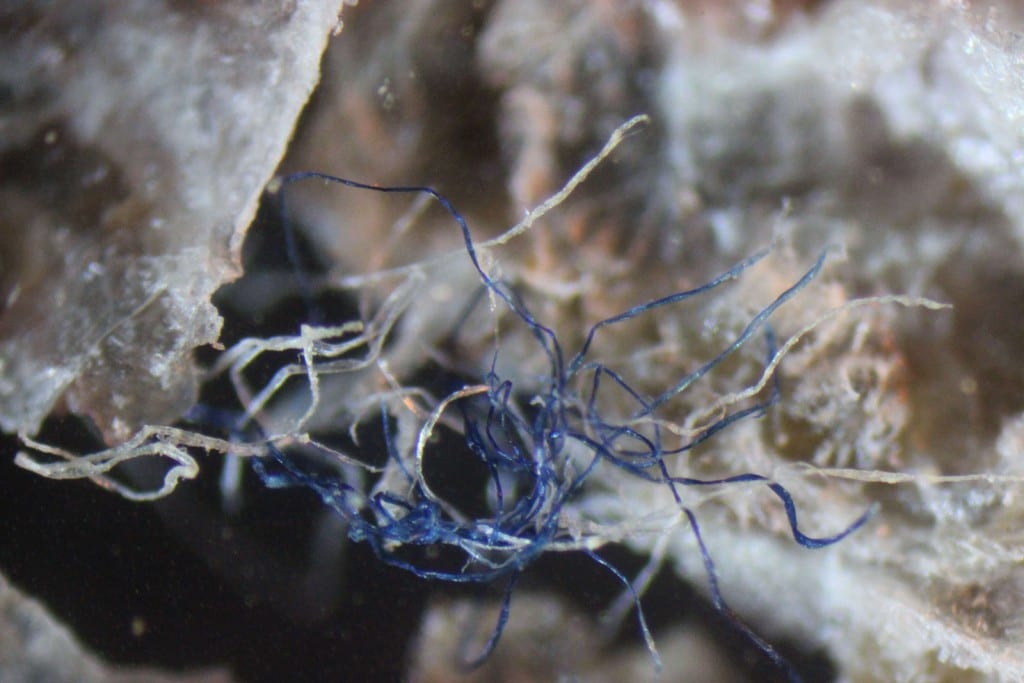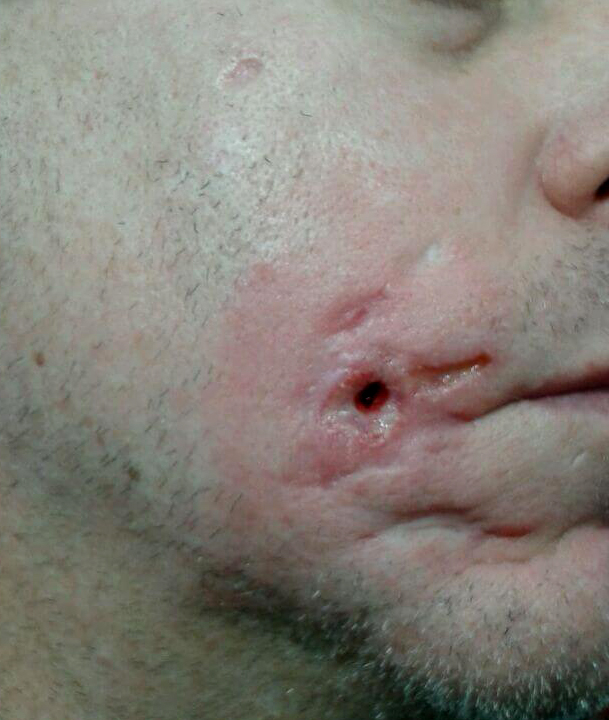TOUCHED BY LYME: Threading your way through Morgellons disease

What can cause weird things to pop out of your skin—perhaps looking like colorful threads of blue, red, white or black? They may even look like seeds or feathers. All this may be accompanied by intense itching, scabs or lesions that don’t heal.
If you go to a dermatologist, you have a high chance of being told that you’re making up your symptoms. “Delusions of Parasitosis” or DOP is the label often slapped on the unfortunate souls who find themselves in this predicament. (How do you “make up” something that looks like a feather poking out of your skin, when other people can see it, too?)
Dr. Ginger Savely may know more about the unusual condition more properly called Morgellons disease than anybody else on the planet. In 2003, she was working as a nurse practitioner in Texas, developing an expertise in treating Lyme disease. As she explains in her new book “Morgellons: The Legitimization of a Disease”:
A dozen or so of my Lyme patients had mysterious, spontaneously appearing, slow-healing lesions with unusual colored filaments embedded in and/or extruding from their skin. Other doctors had diagnosed these patients with “Delusions of Parasitosis” but I was beginning to have some success treating them with antibiotics….I knew these patients were not delusional because I had observed the filaments myself using lighted magnification. I had tried to extract the embedded filaments but since they were firmly and deeply attached my attempts to remove them caused patients deep radiating pain.
When a local TV reporter produced what turned out to be a powerful, award-winning news segment about Savely’s work with Morgellons patients, suddenly her phone began ringing off the hook with other folks in the same boat.
All of these people described the EXACT same long list of perplexing symptoms. This was before the disease had developed media notoriety so patients could not have been telling me the “right” symptoms in order to gain my attention.
Over the next decade, Savely would treat hundreds of Morgellons patients, most of whom turned out to have Lyme disease as well. She also conducted research, published articles, and stood up for this medically ignored population in media interviews and presentations at professional conferences. Her book “Morgellons” is a compendium of what’s known about the still-mysterious condition.
She includes the history of the disease, its signs and symptoms, the most common ways it’s misdiagnosed—and it’s pretty much always misdiagnosed—and which treatments she finds to be helpful. (Savely notes that Lyme disease treatment is less likely to help Morgellons symptoms than treatment for another tick-borne infection, Bartonellosis.)
She also discusses the state of research into the disease. (Hint: public funding for Morgellons research is non-existent. What research has occurred has been paid for by private donations.)
If you or a loved one has symptoms that might be Morgellons, I recommend you get your hands on a copy of this highly informative book immediately.
In order to keep the cost of the book down, it has been printed in black and white. However, if you go to Savely’s website, you can see the book’s photos of Morgellons filaments and lesions in eye-popping color. Here are a few examples:
For more photos, go to http://gingersavely.com/morgellons-book/
TOUCHED BY LYME is written by Dorothy Kupcha Leland, LymeDisease.org’s VP for Education and Outreach. She is co-author of When Your Child Has Lyme Disease: A Parent’s Survival Guide. Contact her at dleland@lymedisease.org.























Thank you for the excellent review of Ginger’s book! Morgellons is extremely painful, disfiguring and disabling and the medical system failed us. Morgellons patients may be the most cruelly victimized of all the tick borne diseases. There is a strong opposition to the legitimization of Morgellons despite scientific evidence to the contrary. But thankfully that didn’t stop Ginger from helping me and hundreds of others!
Ouch!!!!! How can a person have sores like that and be told they’re making it up? Definitely an infection. And since so many of the people with this also have Lyme, it’s a safe guess that it is probably related to tick borne diseases. Our medical systems are so far behind on these diseases.
When I was study medicine in Mexico, i had a medic profesor of internal medicine how suffer Morgellons. It was very sad, that a medic, a specialist! was ignored and treated like a crazy person. I saw fibers comming out of his nail beds.
Now I will be able to treat those patients. Medicine in many cases, is in the point that if pharmaceuticals and big coorporations dont discover the illnes, does not exist. Its a shame and obscure era of science.
Where is everybody? What happened to the people that were going to research what this is and how to treat it. I have had this hell for 5 years and no one will help me. I am a hospice nurse. I have so much compassion and apathy, I can’t believe that others can be so cold.
Dear reesebud,
I’m a retired RN. I have also had these s/s for years. I have tried many treatments. The latest thing I am checking on is treating it like Bartonellosis. I feel for you. I wanted you to know. I care & this is what I’m trying.
Linda
Try wet sanding an abalone shell. And smear the dust on the infected areas. It works
Hi, My name is Jay Jarek, I live on the Big Island of Hawaii. Years ago I was having a reaction that felt like there was something growing on me, (feels like something crawling) People and Doctors told me that I was delusional ? One day, I put Elmers wood glue on my skin, and wow, whatever this Morgellons is, It doesn’t like wood glue ? Lots of stuff was coming off with fibers on it, and vine looking, transparent stuff ? I don’t Know, but I want someone who is like me to try it, and tell me what you think ? Elmers white glue, or Elmers wood glue works the best ? Mahalo
P.S. I can Take pictures of the stuff That comes off of me ? Its like Transparent Vines with seeds and it has dirt, different color fibers, some off it is darker and harder than the lighter stuff. It seems like It makes welts like zits were it connects itself to the skin ?
Did you just put the glue on one spot or what? I have this now from head to toe, just cant take much more of this. So how are you now?
( Elmers wood glue) It doesn’t get rid of it, but it irritates it so bad that you can feel it pinching you from pore to pore. It feels so good, but doesn’t kill it. And if you let it dry, you can peel it off, and it looks like a vine, or kinda like a spider web. There is gritty stuff too. All Im saying is that Medical Labs need to experiment with what I have found, and that is Morgellons hates Elmers glue.Please try it, and text me back to let me know if it does anything for you ?
I have been dealing with this disease for 7 years and it’s getting progressively worse, to the point where I don’t know how I can handle it much longer. I’ve tried numerous so called remedies to no avail. I’ve been told I’m hallucinating and/or crazy by doctors. I won’t even bring it up with my primary because I don’t want to have to go thru the process of finding another one because of the reaction I will get. I’m really at my wits end.
So sorry to hear what you’re going through. Have you been in touch with any of the Morgellons support groups? They may have useful advice.
I just saw this site for the first time and having had to suffer like all of you for the last ten years, (still) and being shunned by doctors and family as well, i am very anxious to read the book and very thankful to the brave author. I am wondering if a large majority of patients also suffer with actual worms and/or bug type creatures in their skin because i have noticed that many articles i have read so far have made no mention of this problem as it relates to the disease. When i viewed the illustrations in the book, the patient with the facial lesions had what seemed to me an obvious problem of worm infestations in his skin with visible worms and outlines of them in many places. Many other illustrations appeared to show some evidence of this as well. Is this type of infestation common for the majority of patients or just an extra goodie for us really lucky ones?
I don’t know how common these worm-like outlines or trails are to other sufferers. But I have plenty of those on my skin. So you’re definitely not alone. But without a definitive conclusion on the cause, you can’t completely rule out whatever worm or parasites in your body might just coexist and interact with Morgellons.
Went to port arthur beach texas and got bit by a sand fly. I need more information on this disease because dermatologists are saying its mental while i know it is not. I put some of these crusty scabs n toilet and they spin like a top. There seems to be different stages because some sre like burs some are like black round dots others appear to have sharp angles like those metal anchors they use to secure a glass window to frame I was told it might be lachmanicis spelled wrong
Im 54 year old female and Ive had MD for 4 years now. I have tried everything to kill this bug. The only way I keep it from spreading is abalone shell dust. I have been using it for a year now and I am convinced it is killing it or keeping it from spreading. I thought it would be helpful if the MD community knew about this. Maybe research and development of parasites could come up with a medication.
Hi I am 49 y/o female RN. Mine started in 2016. I do all types of txs. How are you now? I have been improving but still very present. This has cost me my career interested in all successful tx.
Try wet sanding the abalone shell and wipe the dust on the affect areas wait till your skin is dry to put clothes on.sand the shell wet its toxic but wont hurt you i even get it in my eyes.